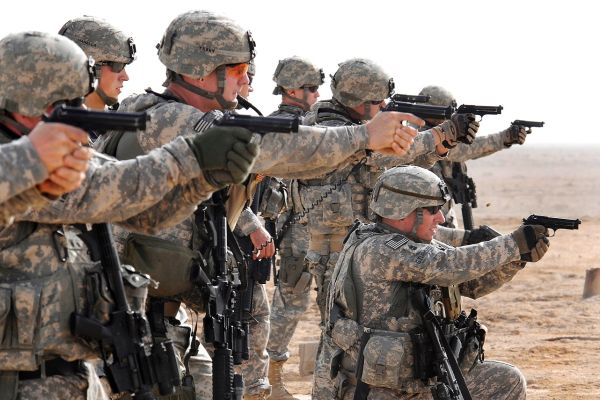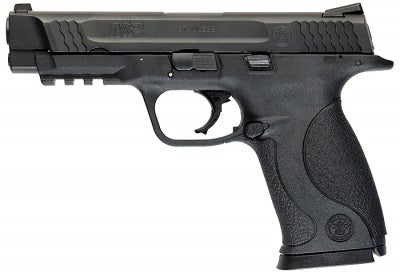Over the summer the U.S. Army announced they’re looking to replace the Beretta M9, which has been the standard issue service weapon for soldiers since 1985. Yes, it’s been 30 years, but before the M9, there was a bigger, badder gun. In 1911, our Armed Forces started using the .45 ACP M1911 after the adrenaline-fueled charges of the Moro Warriors against the U.S. Cavalry proved more powerful than the .38 Long Colt M1892 revolvers the men were issued. The famous Thompson-LaGarde Tests played a large role in the choice to go with .45 ACP; although ammunition has improved since 1904, the .45 ACP has always been a one-shot stopper. So why did the army switch to the M9?
Well, even though most branches of the military used the M1911, the Air Force didn’t, and in the 1970s the DoD decided everyone should carry the same pistol. The reality was the DoD wanted a common NATO pistol round to make things easier if war broke out with the Soviet Union. So in 1979 they formed the Joint Service Small Arms Program, and, long story short, the 9x19mm was chosen as the best match for the NATO STANAG. The usual competition began between manufacturers, and Beretta ended up winning the contract, beating out H and K, Colt, and Smith and Wesson, among others. (It wasn’t that simple. There were disagreements, so multiple trials took place; in the end, Beretta came out on top.)
Since it would take awhile to get detailed, let’s keep this short and sweet (If you all want the in-depth version, let me know in the comments or via email and I’ll see what I can do). The M9 was adopted in 1985 by USAF and was seeing regular use by 1990, but not everyone was happy. USSOCOM was formed in 1987, and before long they decided they didn’t like SOF going into combat with a 9mm. Things move slowly in the military, so it wasn’t until 2005 the Joint Combat Pistol program was formed as the result of a series of events it would take awhile to explain (Again, want the long version? Tell me.). JCP ended up without an actual result when various branches started dropping out, so USSOCOM decided their men should return to the .45 ACP and the army opted to stick with the M9, and they have – until now.
Last summer the army announced – again – they intend to replace the M9. And, as I said, the military moves slowly, so the army is starting the competition now, before their current contract with Beretta runs out (it’s scheduled to end in 2017). They’re calling it the Modular Handgun Systems (MHS) and the point is not only to replace the M9 but to look at a larger caliber. For years the army has claimed the infantry needs those 9mm pistols due in large part to their greater mag capacity, and there are soldiers who say they’d rather have more rounds than bigger ones. Of course, thanks to the Hague Convention our military has to use FMJ rounds in combat (yes, there are rare exceptions such as for Tier One SMUs – again, long explanation), so consider that before saying the M9 is sufficient.
Smith & Wesson is throwing their hat (gun?) in the ring again for the MHS, but this time they aren’t going it alone. They’ve joined forces with General Dynamics Ordnance and Tactical Systems, a company that manufactures all sorts of munitions, weapons, armament systems, and shaped charge and penetrator warheads – just to name a few. General Dynamics is a leader in their field, and we all know Smith & Wesson’s 160-plus year history. Also, General Dynamics has extensive experience with military contracts; by combining powers the two mammoth companies could make quite a mark on the MHS.
Their plan? Create a handgun for the army based on the M&P, of course. The M&P is about to celebrate its 10th anniversary; it’s already used by law enforcement agencies both here in the States and all around the world and there’s its not-inconsiderable popularity with civilians. Smith & Wesson notes the M&P platform already meets many of the MHS requirements including those for safety, performance, and durability. The belief is the pistol could handle the substantial abuse it would be put through as a service weapon, and maybe it can. We’re about to find out.
With these two teaming up you have to wonder if other manufacturers will take their lead and go looking for partners. Pooling knowledge is a good idea, there’s no arguing that. Here’s what I’m wondering: will their offering be any different than the current M&P, or will it be the same pistol with a new name? The M&P is certainly a nice pistol platform – if you’ve fired one you can see why so many shooters like them – but is it what the army needs? Is it what the infantry wants? There are more than a few combat-seasoned Grunts out there using the M&P as their personal carry weapon stateside, so maybe it’s a natural move – maybe it’s brilliant.
What do you think, is an army version of the M&P going to be the next M9? (Don’t forget to start arguing over caliber while you’re at it.) The MHS competition is set to begin in January 2015; personally, I’m looking forward to seeing what new handguns hit the civilian market as the various manufacturers vie for the contract.
Update: TFB writer Nathan S, who previously worked in the defense industry, writes …
My surprise does not mean that its not a smart decision. Major military contracts require established contracting history (often as a significant component in the weighted decision). Smith & Wesson, while very well established in the civilian sector, does not have long history with the military, hence GD’s involvement.
Further, acceptance of large contracts often requires companies to open their books to the Government, something companies do not take likely. Putting my business hat on, GD will act as the prime contractor with Smith & Wesson as the supplier, simultaneously shielding them from major contracting requirements and giving the group established history for the bid.
All in all, I see this as a good move for S&W.
 Your Privacy Choices
Your Privacy Choices




